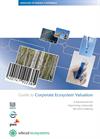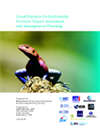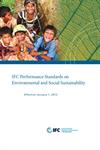
Coalition for Private Investment in Conservation
cpicfinance.com
The Coalition for Private Investment in Conservation (CPIC) is a group of leading civil society organizations, private and public sector financial institutions and academia working to deliver a material increase in private, return-seeking investment in conservation.
The CPIC is developing new investment models and funding pipelines that will help close the current conservation funding gap and contribute to the global goals for biodiversity conservation and sustainable development. More on related resource: http://cpicfinance.com/resources/related-reports/

Corporate Ecosystem Services Review (ESR)
www.wri.org/publication/corporate-ecosystem-services-review
Developed by WRI, in conjunction with WBCSD and the Meridian Institute, this tool enables companies to identify business risks and opportunities arising from company’s dependence and impact on ecosystem services. Can be applied at site, market, product or sector level and can feed into Environmental Impact Assessments. Can also help identify new markets/ products. Following this, an initiative has been developed to determine how ecosystem services can be integrated into existing tools and management systems.

Corporate Ecosystem Valuation
www.wbcsd.org/Clusters/Natural-Capital-and-Ecosystems
/Resources/Guide-to-Corporate-Ecosystem-Valuation
This framework enables companies to consider the actual benefits and value of the ecosystem services they depend upon and impact, giving them new information and insights to include in business planning and financial analysis. This will support improved business decision-making by creating more alignment between the financial, ecological and societal objectives of companies. The guide operationalizes at the company level the framework proposed by The Economics of Ecosystems and Biodiversity (TEEB) initiative of the G8 Environment Ministers (2007/2010).

Good Practices for Biodiversity Inclusive Impact Assessment and Management Planning
publications.iadb.org/handle/11319/7094
This document is produced for project developers and their consultants responsible for preparing Environmental and Social Impact Assessments (ESIAs). It summarizes "good practices" for biodiversity inclusive impact assessment and management planning in ESIAs. The document is based on a review and synthesis of various reports and guidance documents from multi-lateral finance institutions (MFIs), government regulators, industry associations, and non-governmental organizations (NGOs). It is not intended to replace ESIA guidance, but rather to supplement it where biodiversity is not adequately covered. This document is a companion to Good Practices for the Collection of Biodiversity Baseline Data.

IFC Performance Standards on Environmental and Social Sustainability
www.ifc.org/wps/wcm/connect/c8f524004a73daeca09afdf998895a12
/IFC_Performance_Standards.pdf?MOD=AJPERES
The Performance Standards are directed towards IFC clients, providing guidance on how to identify risks and impacts, and are designed to help avoid, mitigate, and manage risks and impacts as a way of doing business in a sustainable way, including stakeholder engagement and disclosure obligations of the client in relation to project-level activities. The Performance Standards may also be applied by other financial institutions. There are eight performance standards relating to: Assessment and Management of Environmental and Social Risks and Impacts; Labor and Working Conditions; Resource Efficiency and Pollution Prevention; Community Health, Safety, and Security Performance Standard; Land Acquisition and Involuntary Resettlement; Biodiversity Conservation and Sustainable Management of Living Natural Resources Performance; Indigenous Peoples; and Cultural Heritage.
IUCN Business and Biodiversity
www.iucn.org/about/work/programmes/business
The Global Business and Biodiversity Programme was established in 2003 to influence and support private partners in addressing environmental and social issues. The Programme's key priority, based on a strategy approved by the IUCN Council, is to engage the business sectors that have a significant impact on natural resources and livelihoods. These include: large 'footprint' industries such as mining and oil and gas; biodiversity-dependent industries including fishing, agriculture and forestry; and, financial services and “green” enterprises such as organic farming, renewable energy and nature-based tourism. IUCN seeks to build an action-based relationship with business that goes beyond Corporate Social Responsibility obligations, addressing the root causes of environmental degradation. The Global Business and Biodiversity Programme provides a wide range of expertise. It builds bridges between stakeholders, carries out independent scientific assessments, and develops conservation policy standards and tools. IUCN's Business Engagement Strategy and its related Operational Guidelines help outline and monitor IUCN’s engagements.

IUCN Red List of Threatened Species
www.iucnredlist.org
The list of threatened taxa is maintained in a searchable database by the SSC Red List Programme as part of the SSC's Species Information Service (SIS). A subset of the records is provided here through the Search and Expert Search functions on the home page